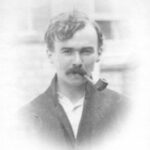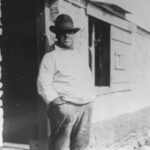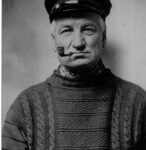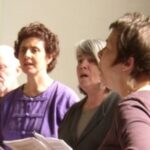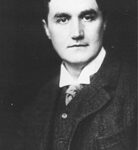Ralph Vaughan Williams, the quintessential English composer, based many of his compositions, including Norfolk Rhapsody, on tunes from the English folk tradition. In 1903, aged 31, he started to go out and listen to an older generation of ‘traditional’ singers – mainly farm workers – and collected hundreds of folk songs by noting them down by hand.
Writing after his death, his widow Ursula gave us an insight into his methods – ‘Notebooks and bicycles were the basic equipment … and a capacity to get on easy terms with the older people whose knowledge of songs and pleasure in them was still lively, as well as a cheerful capacity to drink beer in the pubs where many of the singers could still be found.’
He made at least ten visits to the eastern counties between 1903 and 1913, but also visited other areas of the country, notably Hampshire, Sussex and Surrey. From nearly 800 songs, he noted down only 237 sets of words – and many of those were limited to the first verse only – for Vaughan Williams, it was the tunes which were essential to be saved from oblivion. We have gradually been adding links through to Vaughan Williams’ original notations of the songs, which are housed on the Vaughan Williams Memorial Library website and digitised through the English Folk Dance and Song Society’s project ‘The Full English’ – so far we have done the King’s Lynn and South Norfolk material. Next is to do the Southwold collection and then look in detail at Vaughan Williams’ collecting in the Norfolk Broads and elsewhere in East Anglia. Grateful thanks are due to the English Folk Dance and Song Society for their support. Do take a look at the Full English archive on their website.
Since 2003, the East Anglian Traditional Music Trust has been looking at the songs and singers whom Vaughan Williams met, in particular in Southwold (2003-2004), Kings’ Lynn (2005 – 2014) and south Norfolk (Diss area) (2005-2016). All these projects have included community involvement and teaching the songs to new generations of local people. In 2009 we organised several events which looked at Vaughan Williams work across the eastern counties, including Essex and Cambridgeshire.
Much of the research carried out in connection with these projects is now published on this website, and details of the community events run in each area are also here. We have also published two books about Vaughan Williams’ song collecting in Southwold and King’s Lynn, which include many more photos.
Southwold research
Southwold community project (Blyth Voices)
King’s Lynn research
King’s Lynn community project (North End Voices)
South Norfolk (Diss area) research
South Norfolk community project (Waveney Songs)
Thanks to the Vaughan Williams Memorial Library at the English Folk Dance and Song Society for their unstinting help and support.
Photos, left to right: Ralph Vaughan Williams; George Butterworth, who accompanied Vaughan Williams on several of his song collecting trips in the eastern counties; William Hurr, singer from Southwold; James Carter, singer from King’s Lynn; Chris Coe & singers in Harleston, 2005. Vaughan Williams collected songs from Hurr in 1910, Carter in 1905, and in the Diss area of Norfolk in 1911. Thanks to The English Folk Dance and Song Society, True’s Yard Fishing Heritage Museum and Andrew Jenkins for permission to use these images.
Thanks also to BBC Radio Norfolk, Friends of EATMT and the RVW Society for supporting the North End Voices project and exhibition in 2007-8, and King’s Lynn & West Norfolk Borough Council, Suffolk Coastal District Council, Suffolk County Council, Adnams Charity and Awards for All for supporting earlier projects which resulted in the research, publications and exhibitions about Suffolk and Norfolk.
| 1903 | Essex | East Horndon, Herongate, Ingrave |
| 1904 | Essex | East Horndon, Herongate, Ingrave, Fyfield, Willingale Doe, Little Burstead, Billericay |
| 1905 | Norfolk | Tilney All Saints, Tilney St Lawrence, Kings Lynn |
| 1906 | EssexCambridgeshire | HerongateLittle Shelford, Fen Ditton, Wilburton |
| 1907 | CambridgeshireSuffolk | Fowlmere, Bassingbourne, Meldreth, Cottenham, Fen DittonHadleigh area |
| 1908 | NorfolkCambridgeshire | South Walsham, Horning, Hickling, Acle and Ranworth, West Wratting and Orwell (in the past people believed this to be in Suffolk, because of the river by this name, but EATMT research has identified this as actually being a village in Cambridgeshire) |
| 1910 | SuffolkNorfolk | Shadingfield, Southwold, Reydon, Filby, Rollesby |
| 1911 | NorfolkSuffolk | Diss, Tibenham, ScoleSouthwold |
Other research around East Anglia
In 2006, Sue Cubbin produced an account of Vaughan Williams’ trip to Essex, including 30 songs, called That Precious Legacy. Copies are available from Essex Record Office on 01245 244644.
Mary Humphreys wrote about Vaughan Williams’s work in Cambridgeshire in her book Folk Songs Collected in Cambridgeshire. This may be purchased through Mary’s website.
In 2015, Alan Helsdon collated the findings concerning King’s Lynn, including much work from Liz James. This was published as Vaughan Williams in Norfolk in CDRom form which includes transcriptions and sound files of the songs. A second CD rom, Vaughan Williams in Norfolk Volume 2 was added in 2017 covering his visits in 1908, 1910 and 1911.
Alan in 2020 adapted an article written for the Journal of the Norfolk Wherry Trust for the benefit of EATMT and you can read about Vaughan Williams’s meeting with a William Barlow Debbage in 1908 – Singing Top Hat for EATMT by Alan Helsdon.
In 2022-2023, as part of a national RVW 150 (celebrations of 150 years since Vaughan Williams’ birth) we ran a Heritage Lottery funded project called Vaughan Williams’ Folk which involved his collecting in Essex, Suffolk, Norfolk and Cambridgeshire. Read about this project HERE.
